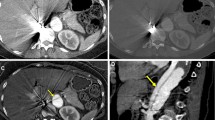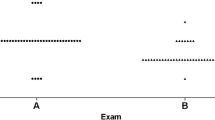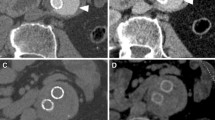Abstract
Purpose
To assess whether virtual non-contrast (VNC) images derived from contrast dual-layer dual-energy computed tomography (DL-DECT) images could replace true non-contrast (TNC) images for aortic intramural hematoma (IMH) diagnosis in acute aortic syndrome (AAS) imaging protocols by performing quantitative as well as qualitative phantom and clinical studies.
Materials and methods
Patients with confirmed IMH were included retrospectively in two centers. For in vitro imaging, a custom-made phantom of IMH was placed in a semi-anthropomorphic thorax phantom (QRM GmbH) and imaged on a DL-DECT at 120 kVp under various conditions of patient size, radiation exposure, and reconstruction modes. For in vivo imaging, 21 patients (70 ± 13 years) who underwent AAS imaging protocols at 120 kVp were included. In both studies, contrast-to-noise ratio (CNR) between hematoma and lumen was compared using a paired t test. Diagnostic confidence (1 = non-diagnostic, 4 = exemplary) for VNC and TNC images was rated by two radiologists and compared. Effective radiation doses for each acquisition were calculated.
Results
In both the phantom and clinical studies, we observed that the CNRs were similar between the VNC and TNC images. Moreover, both methods allowed differentiating the hyper-attenuation within the hematoma from the blood. Finally, we obtained equivalent high diagnostic confidence with both VNC and TNC images (VNC = 3.2 ± 0.7, TNC = 3.1 ± 0.7; p = 0.3). Finally, by suppressing TNC acquisition and using VNC, the mean effective dose reduction would be 40%.
Conclusion
DL-DECT offers similar performances with VNC and TNC images for IMH diagnosis without compromise in diagnostic image quality.
Key Points
• Dual-layer dual-energy CT enables virtual non-contrast imaging from a contrast-enhanced acquisition.
• Virtual non-contrast imaging with dual-layer dual-energy CT reduces the number of acquisitions and radiation exposure in acute aortic syndrome imaging protocol.
• Dual-layer dual-energy CT has the potential to become a suitable imaging tool for acute aortic syndrome.





Similar content being viewed by others
Abbreviations
- AAS:
-
Acute aortic syndrome
- CNR:
-
Contrast-to-noise ratio
- CTA:
-
CT angiography
- CTDIvol :
-
Volume CT dose index
- DL-DECT:
-
Dual-layer dual-energy computed tomography
- DLP:
-
Dose-length product
- DS-DECT:
-
Dual-source dual-energy computed tomography
- IMH:
-
Intramural hematoma
- ROI:
-
Regions of interest
- SD:
-
Standard deviations
- TNC:
-
True non-contrast
- VNC:
-
virtual non-contrast
- WED:
-
Water-equivalent diameter
References
Mussa FF, Horton JD, Moridzadeh R, Nicholson J, Trimarchi S, Eagle KA (2016) Acute aortic dissection and intramural hematoma: a systematic review. JAMA 316:754–763
Hiratzka LF, Bakris GL, Beckman JA et al (2010) 2010 ACCF/AHA/AATS/ACR/ASA/SCA/SCAI/SIR/STS/SVM guidelines for the diagnosis and management of patients with Thoracic Aortic Disease: a report of the American College of Cardiology Foundation/American Heart Association Task Force on Practice Guidelines, American Association for Thoracic Surgery, American College of Radiology, American Stroke Association, Society of Cardiovascular Anesthesiologists, Society for Cardiovascular Angiography and Interventions, Society of Interventional Radiology, Society of Thoracic Surgeons, and Society for Vascular Medicine. Circulation 121:e266–e369
Bhalla S, West OC (2005) CT of nontraumatic thoracic aortic emergencies. Semin Ultrasound CT MR 26:281–304
Romano L, Pinto A, Gagliardi N (2007) Multidetector-row CT evaluation of nontraumatic acute thoracic aortic syndromes. Radiol Med 112:1–20
Song JK (2011) Aortic intramural hematoma: aspects of pathogenesis 2011. Herz 36:488–497
Vilacosta I, San Román JA, Ferreirós J et al (1997) Natural history and serial morphology of aortic intramural hematoma: a novel variant of aortic dissection. Am Heart J 134:495–507
Manghat NE, Morgan-Hughes GJ, Roobottom CA (2005) Multi-detector row computed tomography: imaging in acute aortic syndrome. Clin Radiol 60:1256–1267
Vardhanabhuti V, Nicol E, Morgan-Hughes G et al (2016) Recommendations for accurate CT diagnosis of suspected acute aortic syndrome (AAS)--on behalf of the British Society of Cardiovascular Imaging (BSCI)/British Society of Cardiovascular CT (BSCCT). Br J Radiol 89:20150705
Erbel R, Aboyans V, Boileau C et al (2014) ESC guidelines on the diagnosis and treatment of aortic diseases: document covering acute and chronic aortic diseases of the thoracic and abdominal aorta of the adult. The task force for the diagnosis and treatment of aortic diseases of the European Society of Cardiology (ESC). Eur Heart J 35:2873–2926
Sodickson A, Baeyens PF, Andriole KP et al (2009) Recurrent CT, cumulative radiation exposure, and associated radiation-induced cancer risks from CT of adults. Radiology 251:175–184
Brenner DJ, Hall EJ (2007) Computed tomography--an increasing source of radiation exposure. N Engl J Med 357:2277–2284
Knollmann FD, Lacomis JM, Ocak I, Gleason T (2013) The role of aortic wall CT attenuation measurements for the diagnosis of acute aortic syndromes. Eur J Radiol 82:2392–2398
Godwin JD, Breiman RS, Speckman JM (1982) Problems and pitfalls in the evaluation of thoracic aortic dissection by computed tomography. J Comput Assist Tomogr 6:750–756
McCollough CH, Leng S, Yu L, Fletcher JG (2015) Dual- and multi-energy CT: principles, technical approaches, and clinical applications. Radiology 276:637–653
Altman A, Carmi R (2009) A double-layer detector, dual-energy CT — principles, advantages and applications. Med Phys 36:2750
Fleischmann D, Boas FE (2011) Computed tomography--old ideas and new technology. Eur Radiol 21:510–517
Sellerer T, Noël PB, Patino M et al (2018) Dual-energy CT: a phantom comparison of different platforms for abdominal imaging. Eur Radiol 28:2745–2755
Qin L, Gu S, Chen C et al (2019) Initial exploration of coronary stent image subtraction using dual-layer spectral CT. Eur Radiol. https://doi.org/10.1007/s00330-018-5990-1
Hua CH, Shapira N, Merchant TE, Klahr P, Yagil Y (2018) Accuracy of electron density, effective atomic number, and iodine concentration determination with a dual-layer dual-energy computed tomography system. Med Phys 45:2486–2497
Sauter AP, Muenzel D, Dangelmaier J et al (2018) Dual-layer spectral computed tomography: virtual non-contrast in comparison to true non-contrast images. Eur J Radiol 104:108–114
Graser A, Johnson TR, Hecht EM et al (2009) Dual-energy CT in patients suspected of having renal masses: can virtual nonenhanced images replace true nonenhanced images? Radiology 252:433–440
Ehn S, Sellerer T, Muenzel D et al (2018) Assessment of quantification accuracy and image quality of a full-body dual-layer spectral CT system. J Appl Clin Med Phys 19:204–217
Lehti L, Söderberg M, Höglund P, Nyman U, Gottsäter A, Wassélius J (2018) Reliability of virtual non-contrast computed tomography angiography: comparing it with the real deal. Acta Radiol Open 7:2058460118790115
Toepker M, Moritz T, Krauss B et al (2012) Virtual non-contrast in second-generation, dual-energy computed tomography: reliability of attenuation values. Eur J Radiol 81:e398–e405
Cha D, Kim CK, Park JJ, Park BK (2016) Evaluation of hyperdense renal lesions incidentally detected on single-phase post-contrast CT using dual-energy CT. Br J Radiol 89:1062
Yoo SY, Kim Y, Cho HH et al (2013) Dual-energy CT in the assessment of mediastinal lymph nodes: comparative study of virtual non-contrast and true non-contrast images. Korean J Radiol 14:532–539
Aran S, Daftari Besheli L, Karcaaltincaba M, Gupta R, Flores EJ, Abujudeh HH (2014) Applications of dual-energy CT in emergency radiology. AJR Am J Roentgenol 202:W314–W324
Tijssen MPM, Hofman PA, Stadler AAR et al (2014) The role of dual energy CT in differentiating between brain haemorrhage and contrast medium after mechanical revascularisation in acute ischaemic stroke. Eur Radiol 24:834–840
European guidelines on quality criteria for computed tomography. Available via http://drs.dk/guidelines/ct/quality/mainindex.htm. Last accessed 24 May 2019
Si-Mohamed S, Greffier J, Bobbia X et al (2017) Diagnostic performance of a low dose triple rule-out CT angiography using SAFIRE in emergency department. Diagn Interv Imaging 98:881–891
R Core Team (2018). R: A language and environment for statistical computing. R Foundation for Statistical Computing, Vienna, Austria
New PF, Aronow S (1976) Attenuation measurements of whole blood and blood fractions in computed tomography. Radiology 121:635–640
Kim H, Goo JM, Kang CK, Chae KJ, Park CM (2018) Comparison of iodine density measurement among dual-energy computed tomography scanners from 3 vendors. Invest Radiol 53:321–327
Park KK, Oh CH, Akay M (2011) Image enhancement by spectral-error correction for dual-energy computed tomography. Conf Proc IEEE Eng Med Biol Soc 2011:8491–8494
Ananthakrishnan L, Rajiah P, Ahn R et al (2017) Spectral detector CT-derived virtual non-contrast images: comparison of attenuation values with unenhanced CT. Abdom Radiol (N Y) 42:702–709
Sahni VA, Shinagare AB, Silverman SG (2013) Virtual unenhanced CT images acquired from dual-energy CT urography: accuracy of attenuation values and variation with contrast material phase. Clin Radiol 68:264–271
De Cecco CN, Buffa V, Fedeli S et al (2010) Dual energy CT (DECT) of the liver: conventional versus virtual unenhanced images. Eur Radiol 20:2870–2875
Acknowledgments
We thank Pr. Emmanuel Coche, Dr. Begum Demirler, and Dr.Matteo Pozzi for helping with the clinical study.
Funding
This work has not received any funding.
Author information
Authors and Affiliations
Corresponding author
Ethics declarations
Guarantor
The scientific guarantor of this publication is Professor Loic Boussel.
Conflict of interest
Philippe Coulon, Yoad Yagil, and Nadav Shapira are employees of Philips Healthcare, the manufacturer of the scanner.
Statistics and biometry
Prof. Loic Boussel provided statistical advice for this manuscript.
Informed consent
Written informed consent was waived by the Institutional Review Board.
Ethical approval
Institutional Review Board approval was not required.
Methodology
• Retrospective
• Observational
• Multicenter study
Additional information
Publisher’s note
Springer Nature remains neutral with regard to jurisdictional claims in published maps and institutional affiliations.
Electronic supplementary material
ESM 1
(DOCX 488 kb)
Rights and permissions
About this article
Cite this article
Si-Mohamed, S., Dupuis, N., Tatard-Leitman, V. et al. Virtual versus true non-contrast dual-energy CT imaging for the diagnosis of aortic intramural hematoma. Eur Radiol 29, 6762–6771 (2019). https://doi.org/10.1007/s00330-019-06322-5
Received:
Revised:
Accepted:
Published:
Issue Date:
DOI: https://doi.org/10.1007/s00330-019-06322-5




